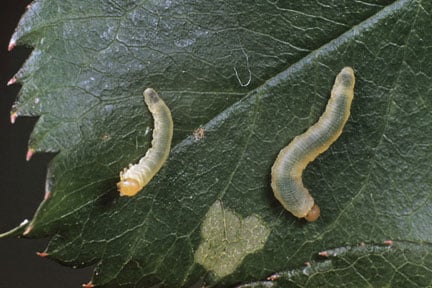
Quick facts
Common name - Rose slug sawfly or slugworm
Scientific name - Endelomyia aethiops
Plants affected - Roses
Main symptoms - The surface of leaves is grazed away and the grazed areas dry up and turn brown
Most active - June to October
What is rose slugworm?
Rose slugworms are the larvae of a . Sawflies are a group of insects in the suborder (Symphyta) of the Hymenoptera (bees, ants and wasps). There are about 500 species of sawfly in Britain. They have caterpillar like larvae that feed on plant material and are named after the saw-like egg laying organ used by females to lay eggs in plant material. Adults can come in a range of colours many are black, green orange or striped yellow and black. Most are small (<1 cm) but some species such as the Birch sawfly (Cimbex femoratus) can be over 2 cm long. Several species can be found in gardens and are part of the a healthy garden will support. More information can be found at The Sawflies of Britain and Ireland webpages.
Adult rose slugworm have black bodies about 4-5 mm long and two pairs of dusky transparent wings, they emerge during mid May to mid June.
Eggs are laid on the foliage and they hatch into larvae that are black with a slug-like appearance. They are pale yellowish-green with light brown heads. Their bodies are translucent and the gut contents can often be seen as a dark green line inside the body. The larvae grow to a length of about 10 mm and are somewhat club-shaped with the head end being swollen. When fully fed the larvae go into the soil to pupate.
There are two or sometimes three generations a year between June and October. The second generation in July and August can be the most abundant. Larvae that complete their feeding late in the year overwinter in cocoons in the soil before pupating in April to May of the following year.
Symptoms
This does not cause any distortion of the foliage and the caterpillars feed exposed on the leaf surface. They are normally found on the underside of leaves but will feed on the upper surface if the plant is shaded.
The larvae do not make holes in the leaves but graze away the leaf surface until only the epidermis remains. Affected areas dry up and become white or pale brown; this type of damage is known as window paning.
Other species of slugworm feed on pear, cherry, lime, oak and willows, these insects are not found on roses.

Management
Rose slugworm can usually be accepted as part of the roses support as the damage to a few leaves will not affect the vigour of plants.
- Where possible tolerate populations of rose slugworm, plants usually recover from defoliation with no effect on flowering
- Encourage predators and other natural enemies of in the garden, such as birds and ground beetles
- Check plants regularly from June for the presence of larvae and remove by hand where practical
Biology
The adult is 4-5 mm long, black in colour with two pairs of transparent wings. The adults fly between May and June. The adult female rose slug sawfly lays eggs individually along the edges of leaves in pockets created by inserting their ovipositor (egg laying organ).
The eggs hatch into, pale green, caterpillar like larvae. These grow up to 12-13 mm (about 1/2 in) long as they feed, characteristically skeletonising leaves. When mature the larvae go down into the soil where they overwinter as non-feeding larvae before pupating the following spring. There is one generation per year.















